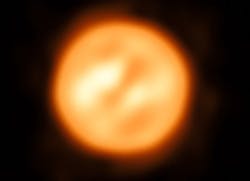ESO's Very Large Telescope Interferometer constructs image of red supergiant star
(Image: ESO) Using the European Southern Observatory's (ESO's) Very Large Telescope Interferometer (VLTI) located at Cerro Paranal, Chile, astronomers have constructed the most detailed image ever of a star -- Antares, a red supergiant with a mass about 12 times that of the Sun and a diameter about 700 times larger than the Sun's.1 They have also made the first map of the velocities of material in the atmosphere of a star other than the Sun, revealing unexpected turbulence in Antares's huge extended atmosphere. The VLTI is a unique facility that can combine the light from up to four telescopes, either the 8.2-meter Unit Telescopes, or the smaller Auxiliary Telescopes, to create a virtual telescope equivalent to a single mirror up to 200 meters across. This allows it to resolve fine details far beyond what can be seen with a single telescope alone. "How stars like Antares lose mass so quickly in the final phase of their evolution has been a problem for over half a century," says Keiichi Ohnaka of the Universidad Católica del Norte in Chile, who is the lead author of the paper. "The VLTI is the only facility that can directly measure the gas motions in the extended atmosphere of Antares -- a crucial step towards clarifying this problem. The next challenge is to identify what’s driving the turbulent motions." Using the new results the team has created the first two-dimensional velocity map of the atmosphere of a star other than the Sun. They did this using the VLTI with three of the Auxiliary Telescopes and an instrument called AMBER to make 311 separate images of the surface of Antares over a small range of infrared wavelengths, forming a spectral "data cube." The team then used these Doppler data to calculate the difference between the speed of the atmospheric gas at different positions on the star and the average speed over the entire star. This resulted in a map of the relative speed of the atmospheric gas across the entire disc of Antares. The astronomers found turbulent, low-density gas much further from the star than predicted, and concluded that the movement could not result from convection. They reason that a new, currently unknown process may be needed to explain these movements in the extended atmospheres of red supergiants like Antares. Source: https://www.eso.org/public/news/eso1726/ REFERENCE: 1. K. Ohnaka et al., Nature (2017); doi: 10.1038/nature23445
